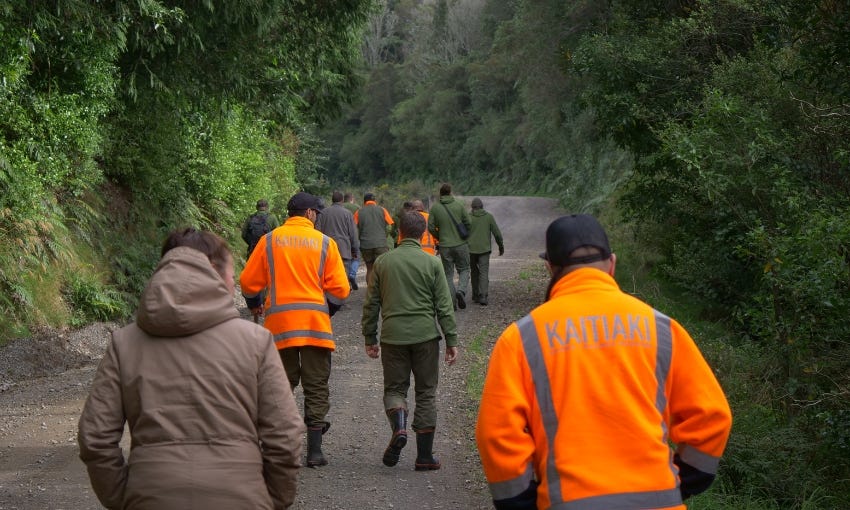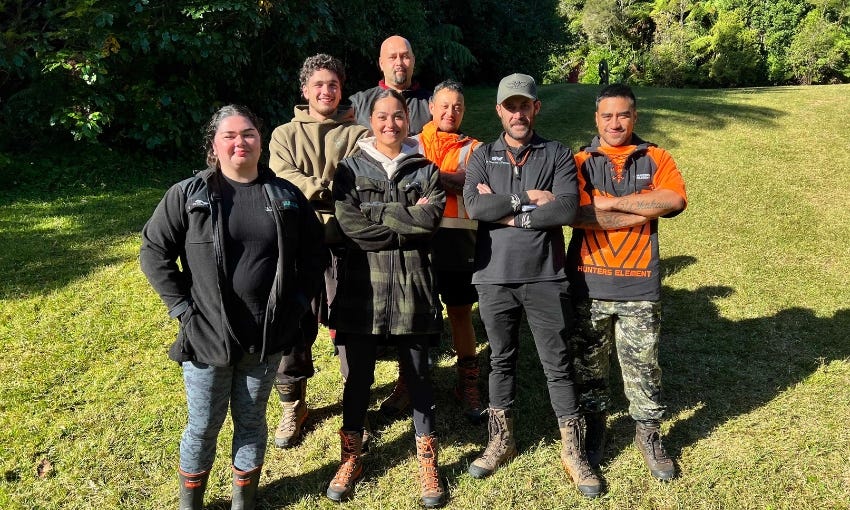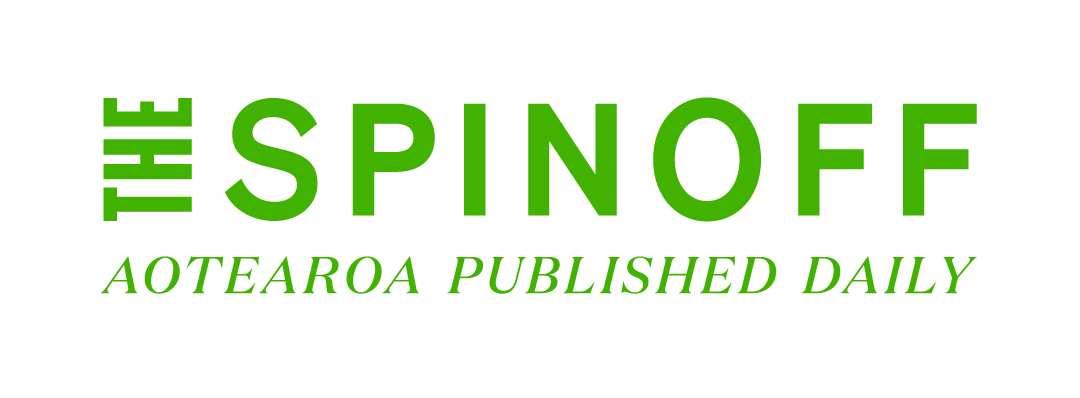Kōkako and co-governance in Kaimai Mamaku
Conservation projects in Kaimai Mamaku are connecting people to the land – and to each other.
Kia ora, welcome to Future Proof. Thanks for joining me. This week: Northland-grown coffee and the TikTok “underconsumption” trend. But first: bringing back the mauri of Kaimai Mamaku.
Kaimai Mamaku Restoration Project kaimahi with Department of Conservation Te Papa Atawhai. Image credit: Manaaki Kaimai Mamaku.
The kōkako is Raponi Te Rangikātukua Wilson’s favourite. He got to hold one during a translocation project, and hearing them sing in the ngahere brings him joy. One day he’d love his kids to wake up to the rich melodies of kōkako ringing out across the bush.
It’s a vision Wilson is actively creating as part of an iwi-led restoration project, Te Wao Nui o Tapuika. The project is delivering pest control across a swathe of land that will connect up two existing kōkako safe zones. A team of “young trappers and hunters extraordinaire” are about to start their big baiting operation – but the project is already a success story.
“It was always about, holistically, how do we empower Tapuika and bring them back to the responsibility that has been handed down to us as kaitiaki of the land?” Wilson says. While a handful of kaimahi are out in the bush, their stories and photos are filtering back to the wider iwi. “The team and their enthusiasm and passion has connected our people with that place again.” A place Tapuika have been living for 800 years.
The team are deploying traditional monitoring, which Wilson describes as centred on “keen observation”. “One of the things our people understood, intrinsically, is that our value is not knowing what's good for the environment, but knowing how to speak to the environment, so that it can tell us what's good for it,” he explains. The project is also “reinventing” the iwi’s mātauranga – much of which had been lost – based on the recollections of elders.
Raponi Te Rangikātukua Wilson (back) and the Tapuika te taiao project team. Image credit: Manaaki Kaimai-Mamaku Trust.
‘A melting pot of conservation effort’
Te Wao Nui o Tapuika is one of 12 projects funded by Jobs for Nature under the umbrella of the Manaaki Kaimai Mamaku Trust. It’s also part of the Kaimai-Mamaku Restoration Project, an “incredible melting pot of conservation effort” across more than 300,000 hectares. “If you look at all the predator-free traps on a map, it looks like a really bad case of the measles,” says Louise Saunders, CEO of the trust.
Saunders has lived alongside the Kaimai Mamaku environment for most of her life, and she says that restoration mahi is something that has deep meaning for a lot of people in the rohe. “So much effort is going into it because people are so jolly concerned about what’s going on. It feels good to take action,” she says. Mobilising folks on the ground will be key as big changes play out across the landscape, she adds. “We're going to need to be super observant across massive scales because we can't survive without the forests. We can't survive without those waterways.”
Future-proofing funding efforts
Jobs for Nature has provided an invaluable foundation to get a new cohort of people trained up to contractor-level proficiency – and co-funding means eight of those 12 projects can continue ticking over.
Now, the trust is looking at what comes next, and tapping into the global shift towards business investment in biodiversity. They’re developing a platform to enable business investment directly in nature conservation projects. “The goal is to have a platform that makes it just as easy for businesses to invest a number of hectares over a number of years in support of project teams going forward,” says Saunders. The trust provides assurance info for investors, so they know the impact on the ground is real.
A positive example of co-governance
The Manaaki Kaimai-Mamaku Trust is proudly co-governed, with both Māori and Pākehā chairs. Wilson and Saunders see the environment as an area where the meeting of te ao Māori and Pākehā worldviews really shines. “Co-governance is actually collaboration, and there’s no better place to deliver collaboration than the environment,” says Saunders.
Wilson recalls a recent wānanga that brought together people from all different projects. “All the workers, the ones that actually see, touch, feel the work, listen to the environment. They came together and there was no difference. The environment is the commonality. That's the focus, and the contentions and the points of difference don’t exist.”
Show your support, join up today!
"Thank you to The Spinoff team for a balanced news, arts, culture, society site, for the (mostly) clear sighted writing and, especially, for the intelligent satire. There needs to be space to be able to laugh" - From a Spinoff member.
If you've appreciated our political satire, as well as our journalism, please consider becoming a member today.
Where does Kamala Harris stand on climate?
If elected US president, Kamala Harris would focus on implementing the Inflation Reduction Act – a Biden administration climate behemoth that she helped pass, which delivers a whopping US$370 billion in funding over 10 years to fuel a green energy transition. Prior to becoming vice president, Harris’ stance on climate change lay much further to the left than Biden, including co-sponsoring the Green New Deal, opposing fracking and offshore drilling, and proposing a price on carbon.
What’s on the menu in a warming New Zealand
Pineapple and coffee in Northland? Kiwifruit crops in Canterbury? Eda Tang surveys how the food we grow in New Zealand might change by mid-century, as the climate warms. But don’t get too excited about a locally grown morning cuppa: rising unpredictability means the climate impact on our food system is really just “solid bad news”.
ICYMI: We’re no longer on track for net zero by 2050
Last Wednesday, the coalition government released New Zealand’s second emissions reduction plan, which sets out the concrete actions the government is taking to meet our emissions budgets. Shanti Mathias has a useful explainer on what’s in the plan, and what experts and campaigners think of it (spoiler alert: not much). But one big takeaway is that we’re no longer on track to meet net zero by 2050, nor the third emissions budget (2031–2035), according to projections included in the plan. Figures released a year ago showed the country was on course for the third emissions budget, but is now facing an overshoot of 17 million tonnes of carbon, RNZ’s Eloise Gibson reports. Part of this is down to differences in modelling, Newsroom’s Marc Daalder points out, but about a third can be chalked up to the government scrapping climate policies like the clean car discount.
More stories
Scientist Mike Joy recounts the incident at a Manawatū river that sparked his freshwater radicalisation and outspoken advocacy for New Zealand’s declining water quality.
A proposal to geoengineer glaciers to slow sea level rise is dividing scientists.
Climate science in New Zealand is under threat, says a climate modeller axed from NIWA this year.
A fascinating read about climate and religion in Taliban-ruled Afghanistan.
What will Auckland be like with two degrees of warming? This interactive explores what will happen to the weather in 70 cities from around the globe as the climate heats up.
We should all talk about climate change more – but is there a right way to talk about it? A new book suggests we’re parroting fossil fuel industry talking points.
An experiment has revealed how kākāpō are escaping over the fence at Maungatautari Sanctuary Mountain.
To finish this issue, a new trend has been taking over TikTok and Instagram: “underconsumption core”. Users share their cupboards of mismatched cups, pared back skincare regime, and other examples of making do with what you already have. The videos reject the excessive consumerism that’s rampant on social media, eschewing fast-fashion hauls, multi-step make-up routines, and the pressure to buy more, now. But as some commenters say: isn’t this – or shouldn’t this – just be normal consumption?
More deinfluencers, please,
Ellen
Future Proof is looking for a sponsor!
Connect your brand with an insightful exploration of environmental news, reaching influential readers committed to sustainability and staying informed about the state of our natural world. Contact commercial@thespinoff.co.nz to learn more.
Got some feedback about Future Proof or topics you’d like covered? Get in touch with me at futureproof@thespinoff.co.nz















Imagine if we consumed things like we lived in 1940s peacetime (no plastic, smaller houses, less stuff), but had the technology of today (renewables, internet for remote working, efficient electric vehicles). We'd be a lot closer to meeting those targets and probably happier too.